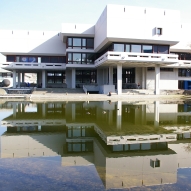Zusammenfassung
A dicopper complex featuring a symmetrically bridging nitrile ligand and supported by a binucleating naphthyridine-based ligand, [Cu-2(mu-eta(1):eta(1)-MeCN)DPFN](NTf2)(2), was treated with phosphaalkynes (RC P, isoelectronic analogues of nitriles) to yield dicopper complexes that exhibit phosphaalkynes in rare mu-eta(2):eta(2) binding coordination modes. X-ray crystallography revealed ...
Zusammenfassung
A dicopper complex featuring a symmetrically bridging nitrile ligand and supported by a binucleating naphthyridine-based ligand, [Cu-2(mu-eta(1):eta(1)-MeCN)DPFN](NTf2)(2), was treated with phosphaalkynes (RC P, isoelectronic analogues of nitriles) to yield dicopper complexes that exhibit phosphaalkynes in rare mu-eta(2):eta(2) binding coordination modes. X-ray crystallography revealed that these unusual "tilted" structures exist in two isomeric forms (R "up" vs. R "sideways"), depending on the steric profile of the phosphaalkyne's alkyl group (R = Me, Ad, or Bu-t). Only one isomer is observed in both solution and the solid state for R = Me (sideways) and Bu-t (up). With intermediate steric bulk (R = Ad), the energy difference between the two geometries is small enough that both are observed in solution, and NMR spectroscopy and computations indicate that the solid-state structure corresponds to the minor isomer observed in solution. Meanwhile, treatment of [Cu-2(mu-eta(1):eta(1)-MeCN)DPFN](NTf2)(2) with 2-butyne affords [Cu-2(mu-eta(2):eta(2)-(MeC CMe))DPFN](NTf2)(2): its similar ligand geometry demonstrates that the tilted mu-eta(2):eta(2) binding mode is not limited to phosphaalkynes but reflects a more general trend, which can be rationalized via an NBO analysis showing maximization of pi-backbonding.






 Altmetric
Altmetric